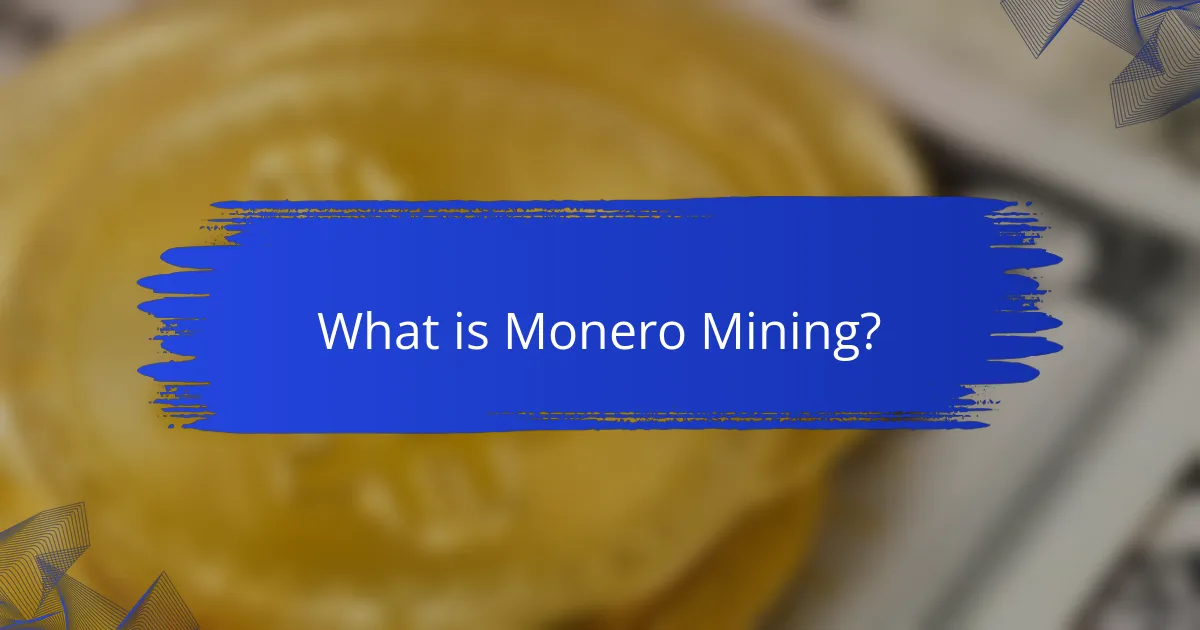Monero mining is the process of validating transactions on the Monero blockchain, utilizing a proof-of-work algorithm called RandomX, which is ASIC-resistant and allows users to mine with standard hardware. Miners are rewarded with Monero (XMR) for adding new blocks, contributing to the network’s security and decentralization. The article covers essential aspects of Monero mining, including its privacy features such as ring signatures, Ring Confidential Transactions (RingCT), and stealth addresses, all designed to enhance user anonymity. Additionally, it discusses software options for mining and the current hash rates, providing a comprehensive guide for those interested in Monero mining and its unique privacy-focused approach.

What is Monero Mining?
Monero mining is the process of validating transactions on the Monero blockchain. It involves solving complex mathematical problems to add new blocks to the blockchain. Miners receive Monero (XMR) as a reward for their efforts. This process is essential for maintaining the security and integrity of the network. Monero uses a proof-of-work algorithm called RandomX. This algorithm is designed to be ASIC-resistant, allowing more users to mine with standard hardware. As of October 2023, Monero’s mining rewards are approximately 1.67 XMR per block. This system encourages decentralization and enhances user privacy.
How does Monero Mining differ from other types of cryptocurrency mining?
Monero mining differs from other types of cryptocurrency mining primarily due to its emphasis on privacy and anonymity. It uses the RandomX algorithm, which is optimized for CPU mining, unlike Bitcoin’s SHA-256 algorithm that favors ASICs. This means that Monero can be mined effectively on standard computers, making it more accessible. Additionally, Monero employs technologies like ring signatures and stealth addresses to obfuscate transaction details. This contrasts with many cryptocurrencies that utilize transparent ledgers. The focus on privacy makes Monero a unique entity in the cryptocurrency space, attracting users who prioritize confidentiality.
What are the key characteristics of Monero as a cryptocurrency?
Monero is a cryptocurrency known for its strong privacy features. It uses ring signatures to obscure transaction origins. This makes it difficult to trace the sender of a transaction. Monero also employs stealth addresses to hide the recipient’s address. This ensures that transactions remain confidential. Additionally, Monero features a dynamic block size, allowing for scalability. This adaptability helps accommodate varying transaction volumes. The currency utilizes a proof-of-work consensus mechanism, which enhances security. These characteristics collectively position Monero as a leading privacy-focused cryptocurrency.
Why is privacy important in cryptocurrency mining?
Privacy is crucial in cryptocurrency mining to protect user identities and transaction details. It prevents malicious actors from tracking miners’ activities and targeting them for attacks. Privacy enhances security by reducing the risk of hacking and theft. It also promotes decentralization by ensuring that no single entity can monitor or control the mining process. Furthermore, privacy helps maintain the integrity of the cryptocurrency ecosystem. In cryptocurrencies like Monero, privacy features are built-in to safeguard users’ financial data. This focus on privacy aligns with the core principles of cryptocurrency, which emphasize autonomy and confidentiality.
What are the main components involved in Monero Mining?
The main components involved in Monero mining are hardware, software, and network. Hardware includes CPUs or GPUs used for processing. Software refers to mining applications that facilitate the mining process. The network consists of nodes that validate transactions and blocks. Monero employs the RandomX algorithm, which is optimized for CPU mining. This makes it accessible for individual miners. Additionally, miners join pools to increase their chances of earning rewards. Each component plays a crucial role in ensuring efficient mining operations.
What hardware is necessary for effective Monero Mining?
Effective Monero mining requires a powerful CPU or a dedicated GPU. The CPU should have multiple cores to handle the mining algorithm efficiently. A recommended choice is the AMD Ryzen 7 series or Intel i7 processors. For GPU mining, high-performance options include NVIDIA GeForce RTX 30 series or AMD Radeon RX 6000 series. Monero uses the RandomX algorithm, which is optimized for CPU mining. Therefore, a strong CPU setup often yields better results than GPUs. Additionally, sufficient RAM, ideally 8GB or more, is necessary to support mining operations. A reliable power supply and cooling system are also crucial to maintain hardware performance and longevity.
What software options are available for Monero Mining?
The software options available for Monero mining include XMRig, XMR-Stak, and Monero Spelunker. XMRig is a popular open-source miner that supports both CPU and GPU mining. XMR-Stak allows for mining with both CPU and GPU, providing a flexible solution. Monero Spelunker is a user-friendly option designed for beginners. Each of these software options is designed to optimize the mining process for Monero’s RandomX algorithm. The effectiveness of these programs can vary based on hardware configurations and user preferences.
What are the benefits of Monero Mining?
Monero mining offers several benefits, primarily focused on privacy and decentralization. It enables users to earn Monero (XMR) by validating transactions on the network. This process enhances network security and transaction anonymity. Monero uses advanced cryptographic techniques to ensure that transaction details remain confidential. It is resistant to ASIC mining, promoting a more egalitarian mining environment. This allows individuals with consumer-grade hardware to participate effectively. Additionally, Monero’s dynamic block size helps maintain transaction speed during high demand. Overall, Monero mining contributes to a robust and private cryptocurrency ecosystem.
How does Monero Mining enhance user privacy?
Monero mining enhances user privacy through its use of advanced cryptographic techniques. These techniques include ring signatures, stealth addresses, and confidential transactions. Ring signatures obscure the identities of senders by mixing their transactions with others. Stealth addresses create unique, one-time addresses for each transaction, making it difficult to trace funds. Confidential transactions hide the transaction amounts, ensuring that only the involved parties know the details. This combination of features ensures that Monero transactions are untraceable and unlinkable. As a result, users maintain a high level of anonymity while mining and transacting.
What economic advantages does Monero Mining offer to miners?
Monero mining offers economic advantages such as profitability, low entry costs, and privacy. Miners can earn rewards through block generation and transaction fees. The current block reward for Monero is approximately 1.2 XMR per block. This creates a steady income stream for miners. Additionally, Monero’s use of RandomX algorithm allows for mining on consumer-grade hardware. This reduces the need for expensive mining rigs. Monero transactions are private, adding a layer of security for miners’ earnings. The decentralized nature of Monero also protects against market volatility. Miners benefit from the potential for long-term value appreciation of XMR.

What privacy features does Monero offer?
Monero offers several robust privacy features. These include ring signatures, which obscure the sender’s identity. RingCT (Ring Confidential Transactions) hides transaction amounts. Stealth addresses ensure receiver anonymity by generating one-time addresses. The blockchain is designed to prevent address reuse. Monero’s dynamic block size allows for adaptable scaling. These features collectively enhance user privacy, making Monero a preferred choice for anonymous transactions.
How does Monero ensure transaction privacy?
Monero ensures transaction privacy through several key technologies. It utilizes ring signatures to obscure the sender’s identity. This technology mixes a user’s transaction with several others, making it difficult to trace. Monero also employs stealth addresses, which generate one-time addresses for each transaction. This prevents the recipient’s address from being publicly linked to the transaction. Furthermore, Monero incorporates confidential transactions, hiding the amount being transferred. These features collectively ensure that Monero transactions are private and untraceable.
What role do stealth addresses play in Monero transactions?
Stealth addresses enhance privacy in Monero transactions. They allow the sender to create a unique address for each transaction. This ensures that the recipient’s actual address remains hidden. Each transaction generates a one-time address that only the sender and recipient can recognize. This feature prevents third parties from linking transactions to a specific recipient. Stealth addresses are part of Monero’s broader privacy framework. They work alongside ring signatures and confidential transactions to obscure transaction details. The implementation of stealth addresses is crucial for maintaining user anonymity in the Monero network.
How does RingCT enhance the privacy of Monero transactions?
RingCT enhances the privacy of Monero transactions by obscuring transaction amounts and sender information. It employs a cryptographic technique called “Ring Confidential Transactions.” This method allows for the verification of transactions without revealing specific details. Each transaction is grouped with others, creating a “ring” of possible senders. This makes it difficult to determine the actual sender among the group. Additionally, RingCT ensures that the transaction amounts are hidden, further protecting user privacy. Monero implemented RingCT in January 2017, significantly increasing its privacy features. The integration of RingCT has made Monero one of the most private cryptocurrencies available.
Why is privacy a critical aspect of Monero’s design?
Privacy is a critical aspect of Monero’s design because it ensures secure and anonymous transactions. Monero employs advanced cryptographic techniques like ring signatures, stealth addresses, and confidential transactions. These features obscure sender and receiver identities, as well as transaction amounts. Unlike Bitcoin, which has a transparent ledger, Monero’s blockchain is designed to be private by default. This privacy protects users from surveillance and potential financial profiling. The demand for privacy in digital currencies has grown due to concerns over data breaches and unauthorized tracking. Monero’s commitment to privacy aligns with the core principles of decentralization and user autonomy.
How does Monero’s privacy features compare to other cryptocurrencies?
Monero’s privacy features are more advanced than most cryptocurrencies. Monero employs ring signatures, stealth addresses, and confidential transactions. These technologies obscure sender and receiver identities, as well as transaction amounts. In contrast, Bitcoin and Ethereum have transparent ledgers. Users can trace transactions on these networks easily. Monero’s privacy is often referred to as “untraceable.” This is a key differentiator. According to a 2021 study by the University of California, Monero transactions are significantly harder to analyze than Bitcoin transactions. This makes Monero a preferred choice for users prioritizing privacy.
What are the implications of Monero’s privacy for users and regulators?
Monero’s privacy has significant implications for both users and regulators. For users, it provides enhanced anonymity in transactions, protecting their financial data from public scrutiny. This privacy feature can deter identity theft and fraud, creating a safer environment for digital transactions. However, it may also attract illicit activities, as users can conduct transactions without revealing their identities.
For regulators, Monero’s privacy poses challenges in enforcing anti-money laundering (AML) and combating the financing of terrorism (CFT) regulations. The opaque nature of transactions makes it difficult to trace funds and identify illegal activities. Consequently, regulators may face hurdles in monitoring compliance and ensuring transparency in the cryptocurrency market.
The balance between user privacy and regulatory oversight remains a contentious issue. As Monero continues to gain traction, discussions around its implications will likely intensify.